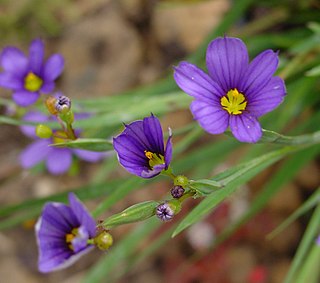
Sisyrinchium is a large genus of annual to perennial flowering plant in the family Iridaceae. Native to the New World, the species are known as blue-eyed grasses and, though not true grasses and in varieties with flower colors other than blue, are monocots.

Abutilon pictum, syn. Abutilon striatum (disputed), is a species of flowering plant in the family Malvaceae. It is native to southern Brazil, Argentina, Paraguay and Uruguay. The plant has become naturalised in Central America, and is used in horticulture. Common names include redvein abutilon, red vein Indian mallow, redvein flowering maple, Chinese-lantern and red vein Chinese lanterns.

Silene flos-cuculi, commonly called ragged-robin, is a perennial herbaceous plant in the family Caryophyllaceae. This species is native to Europe and Asia, where it is found along roads and in wet meadows and pastures. In Britain it has declined in numbers because of modern farming techniques and draining of wet-lands and is no longer common. However, it has become naturalized in parts of the northern United States and eastern Canada.

Geranium sanguineum, common names bloody crane's-bill or bloody geranium, is a species of hardy flowering herbaceous perennial plant in the cranesbill family Geraniaceae. It is also the county flower of Northumberland.

Helianthemum nummularium is a species of rock-rose (Cistaceae), native to most of Europe.

Rosa chinensis, known commonly as the China rose, Chinese rose, or Bengal rose, is a member of the genus Rosa native to Southwest China in Guizhou, Hubei, and Sichuan Provinces. The first publication of Rosa chinensis was in 1768 by Nikolaus Joseph von Jacquin in Observationum Botanicarum, 3, p. 7 & plate 55.

Sisyrinchium montanum, the blue-eyed-grass, American blue-eyed-grass, or strict blue-eyed grass, is a grass-like species of plant from the genus Sisyrinchium, native to northern North America from Newfoundland west to easternmost Alaska, and south to Pennsylvania in the east, and to New Mexico in the Rocky Mountains. It has also been introduced to parts of France, likely during the First World War.

Hylotelephium spectabile is a species of flowering plant in the stonecrop family Crassulaceae, native to China and Korea. Its common names include showy stonecrop, iceplant, and butterfly stonecrop.

Oenothera suffrutescens is a species of flowering plant in the evening primrose family known as scarlet beeblossom and scarlet gaura.
Pyracantha atalantioides is a species of Firethorn shrub.
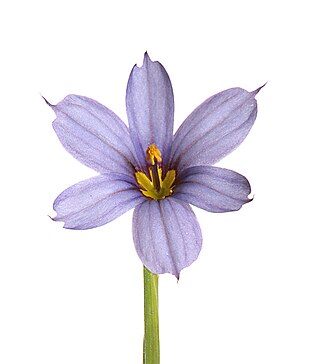
Sisyrinchium angustifolium, commonly known as narrow-leaf blue-eyed-grass, is a herbaceous perennial growing from rhizomes, native to moist meadow and open woodland. It is the most common blue-eyed grass of the eastern United States, and is also cultivated as an ornamental.
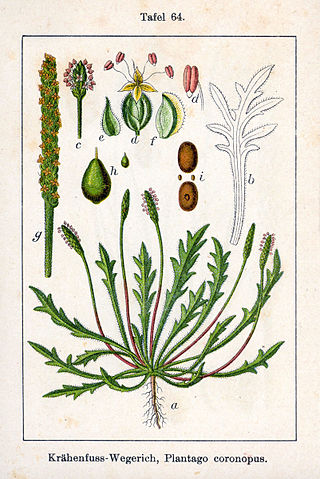
Plantago coronopus, the buck's-horn plantain, is a herbaceous annual to perennial flowering plant in the family Plantaginaceae. Other common names in the US and Italy include minutina and erba stella.

Sisyrinchium pruinosum, the dotted blue-eyed grass, is a perennial plant in the family Iridaceae, native to the south-central United States. There are also reports of the plant in California, but these appear to represent naturalizations. It is sometimes considered to be a synonym of Sisyrinchium langloisii.
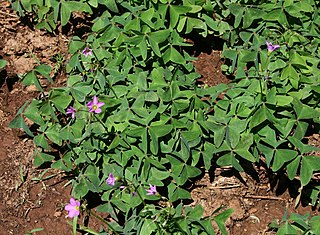
Oxalis latifolia is a species of flowering plant in the woodsorrel family known by the common names garden pink-sorrel and broadleaf woodsorrel. It is native to Mexico and parts of Central and South America.

Sisyrinchium californicum is a species of flowering plant in the iris family known by the common names golden blue-eyed grass, yellow-eyed-grass, and golden-eyed-grass. It is native to the west coast of North America from British Columbia to central California, where it grows in moist habitat, often in coastal areas.

Sisyrinchium micranthum, commonly known as blue pigroot or striped rush-leaf, is a grass-like species in the iris family, Iridaceae. It is native to Mexico, Central America, and South America and widely naturalised elsewhere. The white to cream flowers are between 10 and 20 mm in diameter and have blue to purple centres. These are followed by rounded 3 to 8 mm brown capsules that enclose the dark brown seeds.
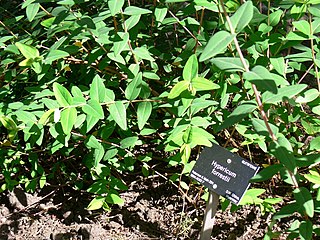
Hypericum forrestii is a species of flowering plant in the family Hypericaceae native to China and Myanmar. It is known as Forrest's tutsan and Forrest's St. John's wort. It was named in honour of the Scottish botanist George Forrest (1873-1932), who was the first westerner to discover it. The species has gained the Royal Horticultural Society's Award of Garden Merit.

Olsynium filifolium , or Bermudiana filifolia, is the only species of the iris family native to the Falkland Islands. It is much better known by its former name Sisyrinchium filifolium. Although it is no longer as common as it once was, it is widely distributed on the islands, and favours temperate dwarf shrub heath. It is also found in Patagonia.

Sisyrinchium bermudiana, known as Bermudiana or, along with other members of the genus, as blue-eyed grass, is a flower of the genus Sisyrinchium that is indigenous to the Atlantic archipelago, and British Overseas Territory, of Bermuda. The plant appears and blooms in the spring. It has been used as a totemic flower by Bermudians, and appears in art, jewellery, banknotes and elsewhere. Long believed to be limited to Bermuda, the plant has also been found around Lough Erne and Lough Melvin in County Fermanagh, Northern Ireland, where it is known as feilistrín gorm, or blue-eyed grass.

Hippeastrum striatum, the striped Barbados lily, a flowering perennial herbaceous bulbous plant, in the family Amaryllidaceae, native to the southern and eastern regions of Brazil.


















